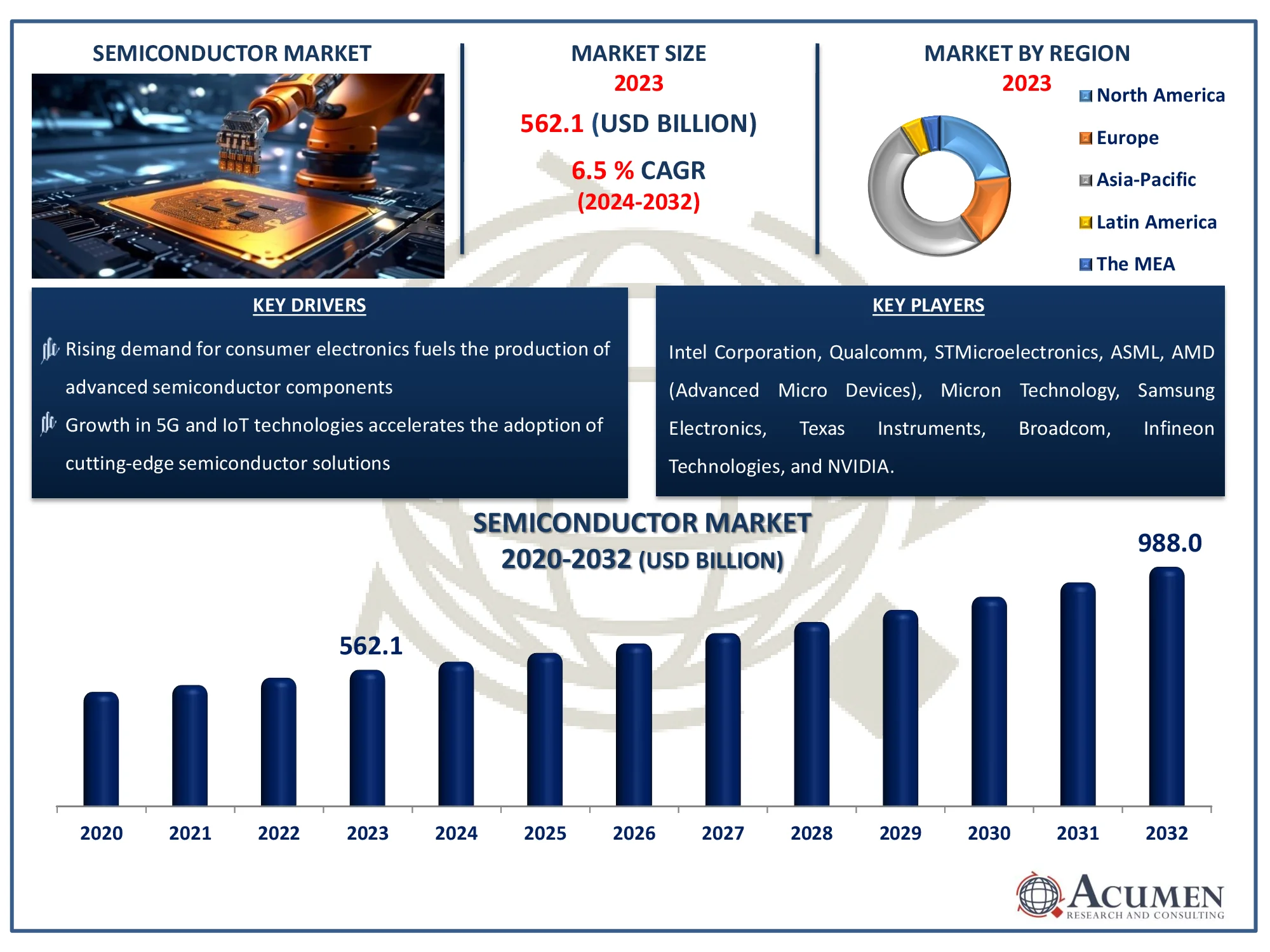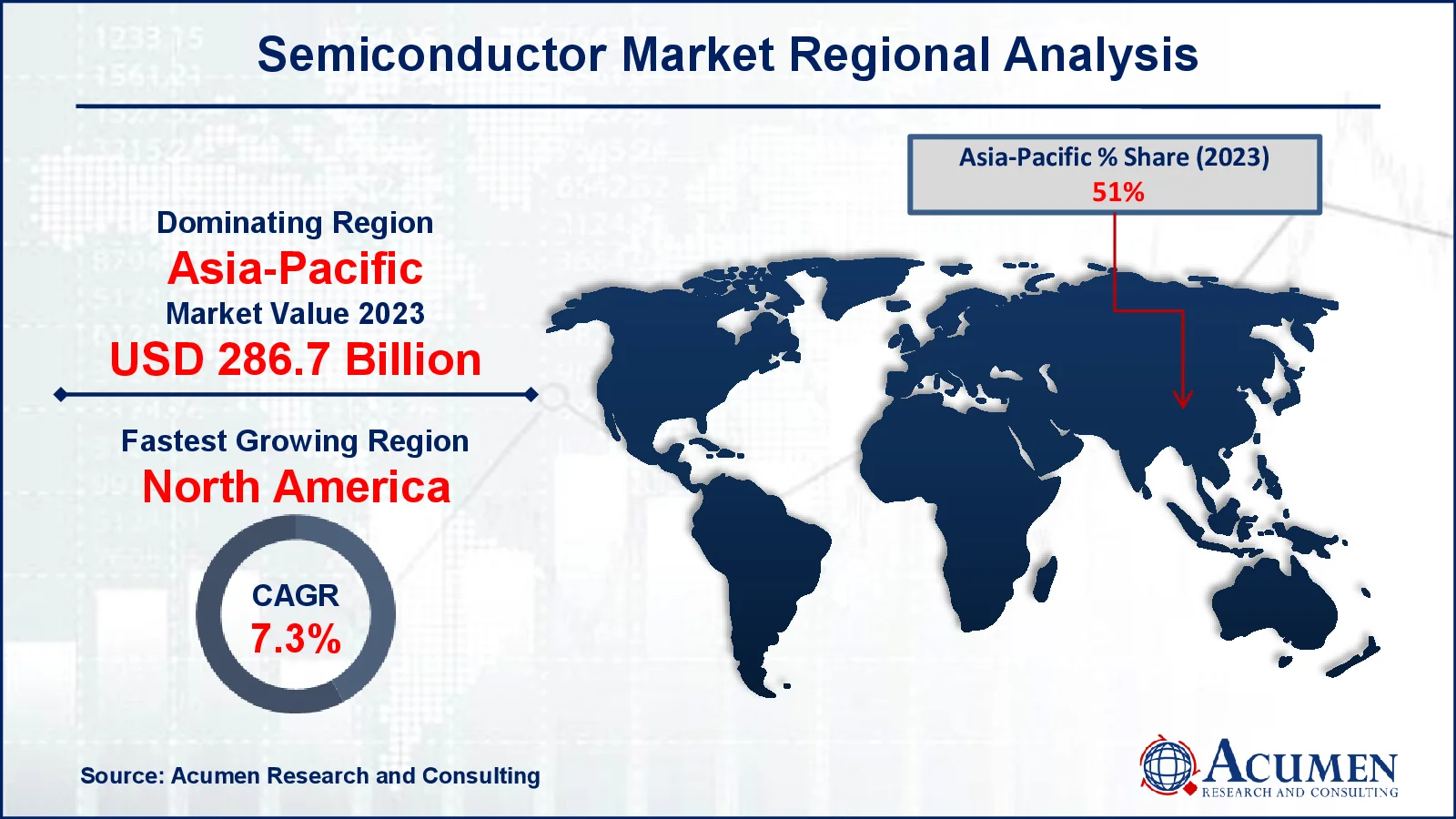Semiconductor Market Size - Global Industry, Share, Analysis, Trends and Forecast 2024 - 2032
Published :
Report ID:
Pages :
Format :
Semiconductor Market Size - Global Industry, Share, Analysis, Trends and Forecast 2024 - 2032
Report Coverage
- Industry Dynamics
- Market Size and Forecast Data
- Segment Analysis
- Competitive Landscape
- Regional Analysis with a Niche Focus on Country-Level Data
- High Level Analysis - Porter's, PESTEL, Value Chain, etc.
- Company Profiles of Key Players
- Option to Customize the Report As Per Your Specific Need
Request Sample Report
The Global Semiconductor Market Size accounted for USD 562.1 Billion in 2023 and is estimated to achieve a market size of USD 988.0 Billion by 2032 growing at a CAGR of 6.5% from 2024 to 2032.
Semiconductor Market Highlights
- Global semiconductor market revenue is poised to garner USD 988.0 billion by 2032 with a CAGR of 6.5% from 2024 to 2032
- Asia-Pacific semiconductor market value occupied around USD 286.7 billion in 2023
- North America semiconductor market growth will record a CAGR of more than 7.3% from 2024 to 2032
- Among component, the memory devices sub-segment generated USD 129.3 billion revenue in 2023
- Based on application, the networking & communication sub-segment generated 32% semiconductor market share in 2023
- Rising demand for edge computing and cloud-based services is a popular semiconductor market trend that fuels the industry demand

A semiconductor is a substance that can transmit electricity between a conductor (such as copper) and an insulator (such as glass). Its ability to carry electricity can be precisely controlled, making it a necessity in modern electronics. Silicon and gallium arsenide are widely utilized semiconductors due to their advantageous characteristics.
Semiconductors are the building blocks of integrated circuits (ICs), transistors, and diodes, which allow gadgets like cellphones, computers, and solar cells to function. Doping is the process of adding impurities to make n-type or p-type semiconductors, which alters their conductivity. This manipulation is the foundation of electrical components. The semiconductor sector is critical to innovation in fields such as artificial intelligence, telecommunications, and automotive technology, propelling progress worldwide.
Global Semiconductor Market Dynamics
Market Drivers
- Rising demand for consumer electronics fuels the production of advanced semiconductor components
- Growth in 5G and IoT technologies accelerates the adoption of cutting-edge semiconductor solutions
- Increased focus on renewable energy drives demand for power semiconductors in solar and wind applications
- Expansion of AI and machine learning applications enhances the requirement for high-performance semiconductors
Market Restraints
- Global semiconductor supply chain disruptions lead to prolonged shortages and delays
- High manufacturing costs and technological complexity hinder new market entrants
- Geopolitical tensions affect trade and disrupt the semiconductor production ecosystem
Market Opportunities
- Growing interest in electric vehicles creates demand for efficient semiconductor solutions
- Expanding adoption of edge computing opens avenues for specialized semiconductor chips
- Government initiatives and investments in semiconductor manufacturing boost regional opportunities
- Rising emphasis on miniaturization enables the development of next-gen nano-sized semiconductors
Semiconductor Market Report Coverage
| Market | Semiconductor Market |
| Semiconductor Market Size 2022 |
USD 562.1 Billion |
| Semiconductor Market Forecast 2032 | USD 988.0 Billion |
| Semiconductor Market CAGR During 2023 - 2032 | 6.5% |
| Semiconductor Market Analysis Period | 2020 - 2032 |
| Semiconductor Market Base Year |
2023 |
| Semiconductor Market Forecast Data | 2024 - 2032 |
| Segments Covered | By Component, By Application, And By Geography |
| Regional Scope | North America, Europe, Asia Pacific, Latin America, and Middle East & Africa |
| Key Companies Profiled | Intel Corporation, Qualcomm, STMicroelectronics, ASML, AMD (Advanced Micro Devices), Infineon Technologies, Micron Technology, Samsung Electronics, Texas Instruments, Broadcom, and NVIDIA. |
| Report Coverage |
Market Trends, Drivers, Restraints, Competitive Analysis, Player Profiling, Covid-19 Analysis, Regulation Analysis |
Semiconductor Market Insights
The electronic sector is experiencing rapid advancements around the world, and ongoing investment in the development of advanced devices infused with AI is resulting in demand for various components such as logic devices, analog IC, and so on. These are some of the factors expected to drive the growth of the global semiconductor market. The creation of smart cities is a priority for both developed and developing countries' governments. They are making significant investments in smart infrastructure development to improve people's quality of life. This results in increased demand for various components from IoT device manufacturers, which supports the growth of the semiconductor sector.
Government is focused on incorporation of AI in various end use industries in order to facilitate the adoption of advanced device. Flourishing automotive sector in developed and developing countries, rising passenger vehicle sales and inclination towards adoption of electric vehicles is expected to support the growth of target market. For instance according to the International Energy Agency In 2023, about 14 million new electric vehicles were registered worldwide. Electric vehicle sales in 2023 were 3.5 million greater than in 2022, representing a 35% year-on-year growth.
In addition, business development activities through strategic merger and acquisitions in order to increase the customer base and enhance the product portfolio is another factor expected to support the growth of target market. Players are focused on increasing the business presence through joint ventures they are enhancing the profit ratio.
However, factors such as high cost associated to R&D activities and high complexity in component manufacturing are expected to hamper the growth of global semiconductor market.
Technological advancements by the major players, high R&D activities, and innovative product offerings are factors responsible to create new opportunities for players over the forecast period. In addition, increasing focus on establishment of new facilities and increasing production capacity are factors expected to support the growth of target market.
Semiconductor Market Segmentation
The worldwide market for semiconductor is split based on component, application, and geography.
Semiconductor Market By Component
- Memory Devices
- Logic Devices
- Analog IC
- MPU
- Discrete Power Devices
- MCU
- Sensors
- Others
According to semiconductor industry analysis, the memory devices category dominates the market due to rising demand for data storage in a variety of applications, including consumer electronics, automotive, and industrial sectors. Memory technologies like DRAM, NAND flash, and SRAM are essential components in cellphones, laptops, servers, and cloud storage systems. The increased demand for high-performance memory solutions, fueled by advances in 5G, artificial intelligence, and IoT, has propelled the growth of memory devices. Furthermore, the rapid expansion of data centers and the advent of smart devices have made memory devices crucial, cementing their position as the largest section of the semiconductor market. The ongoing evolution of memory technologies also helps to the segment's growth.
Semiconductor Market By Application
- Networking & Communication
- Data Processing
- Industrial
- Consumer Electronics
- Automotive
- Government
The networking & communication type drives the semiconductor industry as sophisticated communication technologies such as 5G, IoT, and satellite communications gain traction. The exponential expansion of data traffic, as well as the demand for faster and more dependable connectivity, are driving this industry. Transceivers, RF chips, and CPUs are required to form a robust networking infrastructure, which includes routers, switches, and base stations. The growth of smart gadgets, cloud computing, and edge computing heightens the demand for improved semiconductors in this area. Furthermore, investments in 5G network rollouts and global broadband development secure the segment's continued supremacy in the semiconductor business.
Semiconductor Market Regional Outlook
North America
- U.S.
- Canada
Europe
- U.K.
- Germany
- France
- Spain
- Rest of Europe
Asia-Pacific
- India
- Japan
- China
- Australia
- South Korea
- Rest of Asia-Pacific
Latin America
- Brazil
- Mexico
- Rest of Latin America
The Middle East & Africa
- South Africa
- GCC Countries
- Rest of the Middle East & Africa (ME&A)

Semiconductor Market Regional Analysis
The Asia-Pacific region dominates the worldwide semiconductor industry, with the highest share due to its robust manufacturing ecosystem and high demand for electronic devices. Countries such as China, Taiwan, South Korea, and Japan make significant contributions, with China and Taiwan leading in semiconductor manufacture and assembly. These countries are home to some of the world's largest foundries, such as TSMC and SMIC, which benefit from well-established supply networks and strong government assistance. Furthermore, the expanding consumer electronics sector, together with advances in 5G and IoT, drives demand in the region. The growing use of semiconductors in electric vehicles (EVs) and renewable energy solutions strengthens Asia-Pacific's supremacy. For instance, according to the International Energy Agency in the United States, new electric car registrations reached 1.4 million in 2023, up more than 40% from 2022.
North America is expected to grow the quickest throughout the semiconductor market forecast period, due to significant expenditures in semiconductor manufacturing and innovation. The US government's programs, such as the CHIPS Act, seek to increase domestic semiconductor production while reducing dependency on imports. North America's leadership in AI, cloud computing, and automotive technology contributes to the demand for sophisticated semiconductors. The rise of fabless businesses like Qualcomm and NVIDIA, as well as strategic relationships with manufacturing partners, has boosted the region's growth potential. This dual trajectory demonstrates a dynamic interplay between supremacy in Asia-Pacific and strong growth in North America.
Semiconductor Market Players
Some of the top semiconductor companies offered in our report includes Intel Corporation, Qualcomm, STMicroelectronics, ASML, AMD (Advanced Micro Devices), Infineon Technologies, Micron Technology, Samsung Electronics, Texas Instruments, Broadcom, and NVIDIA.
Frequently Asked Questions
How big is the semiconductor market?
The semiconductor market size was valued at USD 562.1 billion in 2023.
What is the CAGR of the global semiconductor market from 2024 to 2032?
The CAGR of semiconductor is 6.5% during the analysis period of 2024 to 2032.
Which are the key players in the semiconductor market?
The key players operating in the global market are including Intel Corporation, Qualcomm, STMicroelectronics, ASML, AMD (Advanced Micro Devices), Infineon Technologies, Micron Technology, Samsung Electronics, Texas Instruments, Broadcom, and NVIDIA.
Which region dominated the global semiconductor market share?
Asia-Pacific held the dominating position in semiconductor industry during the analysis period of 2024 to 2032.
Which region registered fastest CAGR from 2024 to 2032?
North America region exhibited fastest growing CAGR for market of semiconductor during the analysis period of 2024 to 2032.
What are the current trends and dynamics in the global semiconductor industry?
The current trends and dynamics in the semiconductor industry include rising demand for consumer electronics fuels the production of advanced semiconductor components, and growth in 5G and IoT technologies accelerates the adoption of cutting-edge semiconductor solutions.
Which application held the maximum share in 2023?
The networking & communication application held the maximum share of the semiconductor industry.



